
We’ve been putting off writing this review for a long time now. The film is such a complex, psychedelic dance of themes and stories that the idea of reviewing it properly is terrifying to us. It wasn’t until last night as we were sitting watching a different film with Aunty that she helped us understand another layer of the film. On this layer things become much smaller, easier to review. This film is really a powerful lesson of personal growth for all of us to learn from.
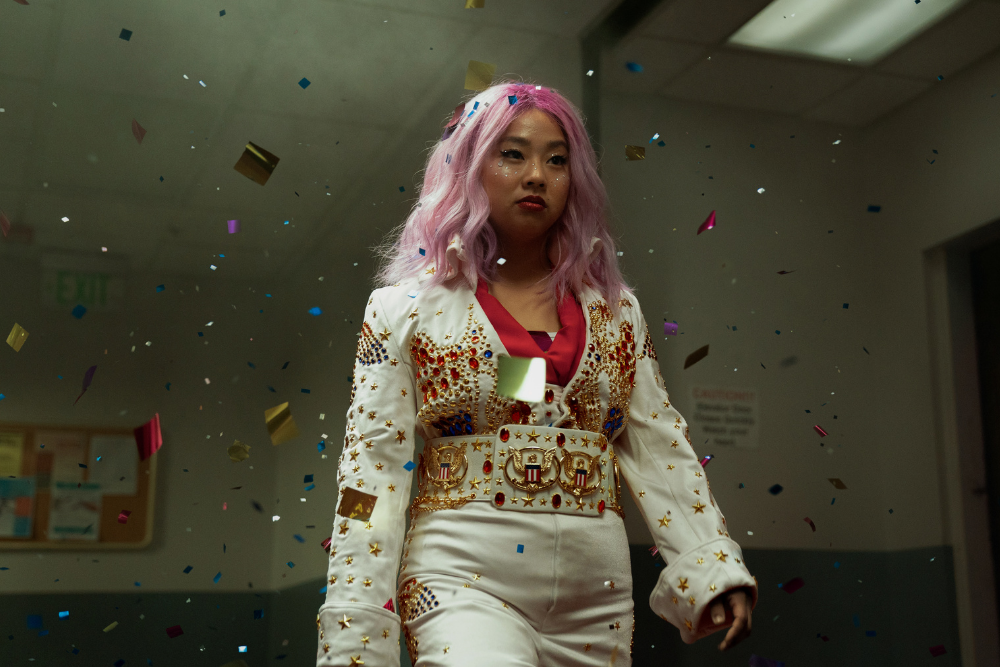
The surface story
On the surface, this film is a story of a Woman’s journey from simple laundry mat operator to cross dimensional god and then back to the laundry mat. The surface story is a story of personal growth, and a powerful one. It includes many elements of eastern philosophy dressed up in a magical new way that makes these concepts easy for us to understand.
We’re not here to lay out the entire plot for you or comment on specific scenes or themes, no, we leave that style of review to the real press. Anyone can identify with Evelyn’s journey, even the mystical elements of the film are dressed in just enough sci-fi to appeal to the western audience. We can understand that all, we can see how Evelyn learns from each of her alternate lives. She eventually transcends violence and decides to heal her enemies instead. It’s a beautiful story of growth and healing.
This surface level view of the film works, and works well, but we believe that there is a deeper lesson here. There is a psychedelic way to look at this story, in this way we gain a completely different understanding and respect for the film. We hope to present this alternate understanding and maybe it will appeal to you as well.
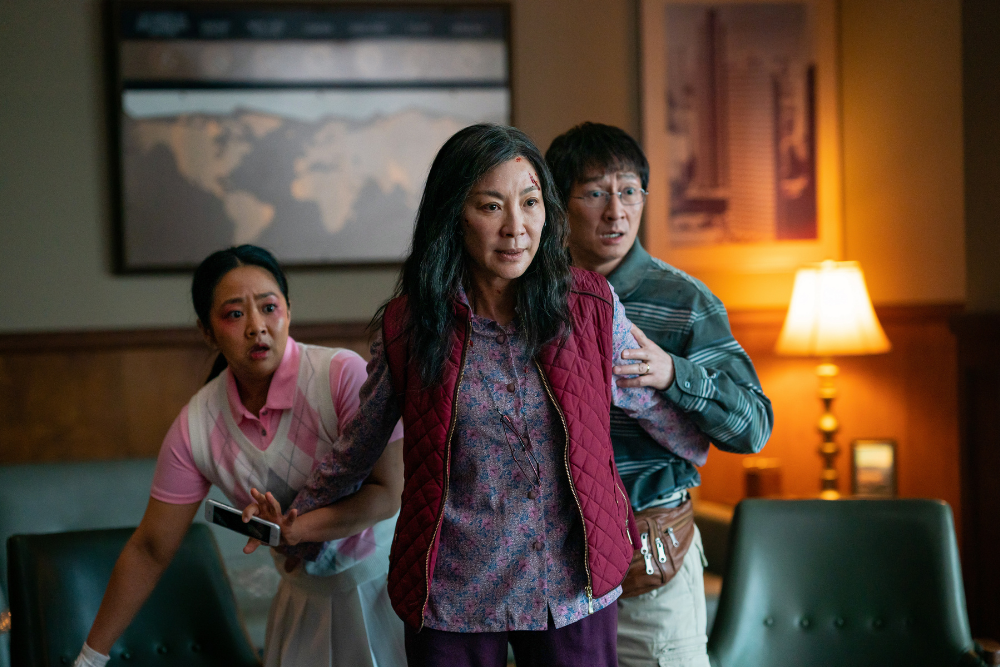
How many evelyns exist?
Rosencrantz & Guildenstern Are Dead is another wondrously creative film, we haven’t reviewed this yet but we will. This film is different from others as it doesn’t tell the “main” story of Hamlet. Rather we get to see the behind the scenes lives of two minor characters who barely intersect the main story except at a few critical points. The rest of the time these characters are just milling about looking for something to do. Being a side character is a weird existence.
How does that relate to Everything, Everywhere All at Once? Well, like us you likely believe that this film is about a singular Evelyn. This Evelyn goes to the IRS, learns to leap through realities, gains a number of skills, learns to love again and then returns to the laundry mat to heal her life. One Evelyn does all these things, she changes over the course of the story, but you likely believe that there was one and only one physical Evelyn throughout the film don’t you?
What if we step away from that view and take a different perspective on the story, a psychedelic perspective. Do you remember when Evelyn was first learning to use the quantum leap ear buds? Back at the IRS, before the first fight with the security guards. She did it wrong the first time. For the sake of this review lets pretend that at this point Evelyn’s existence severed. By the end of the review we will have convinced you of this fact.
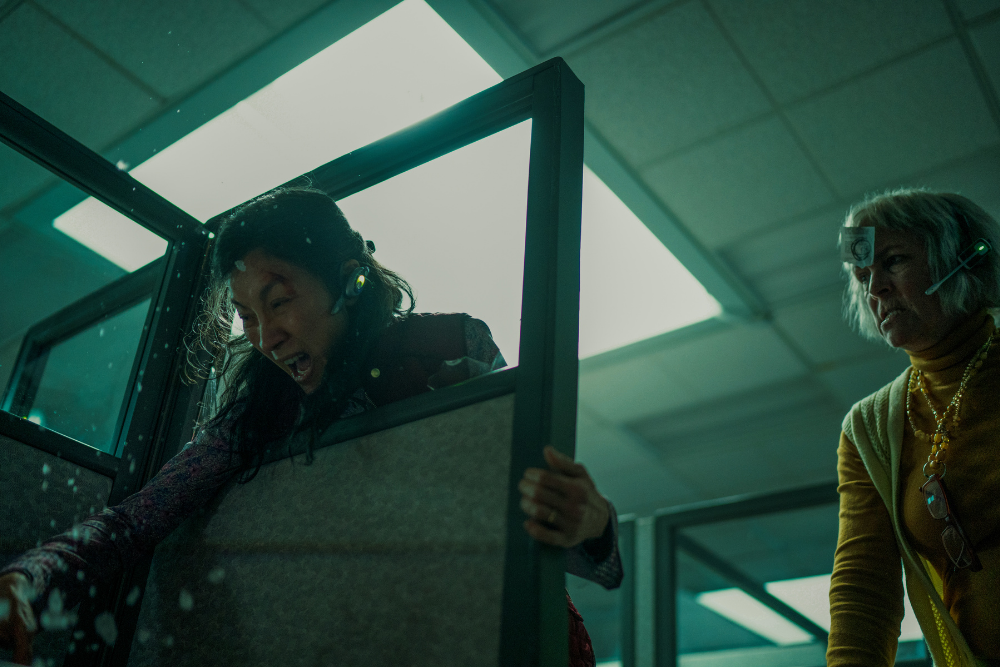
Two evelyns
Two Evelyns exist now, one leaves the IRS never having gotten the ear buds to work. She continues the life path she was on, she continues to play the game as we all have to. She has to go on dealing with the real world, this is the Evelyn we see sitting in the broken down camper discussing divorce with her husband.
Before you reject that idea outright please spend a minute considering it. Try to remember the timeline of the film. This Evelyn that we see in the camper 2 or 3 times cannot possibly be on the same timeline as the Evelyn we see fighting and jumping between realities. This is the great trick of the film, the film blends these two Evelyns together so we think they are singular — but if you actually sit down and think it through, this is impossible.
Why do this? Like we always do on this site, our goal is not to provide you with pie in the sky unachievable goals or philosophies. We want to bring this back down to earth, that is where the practical lessons for us lay.
You see there are no quantum leap earbuds — they don’t exist, they will likely never exist. This means that even if those other versions of us exist, we cannot normally reach them. That doesn’t mean we can’t learn from them. In the psychedelic state of consciousness we can easily embody and explore these alternate selves.
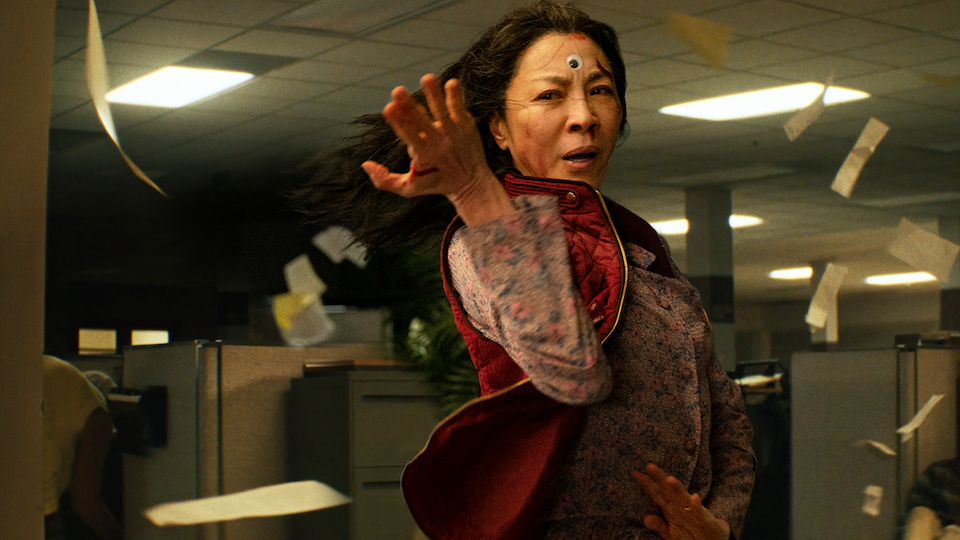
we are the people we choose to be
We see the continuance of reality as a series of choices, decisions we have to make. In eastern traditions this is sometimes thought about as a giant loom, weaving reality from trillions of tiny threads. If you pull on a thread you take that path, pull a different one and you take that path instead. In this way, each decision doesn’t obliterate the others. All the threads exist, all the time.
The film represents this concept in an astounding way, Evelyn is able to “jump” from thread to thread at will by doing something weird. Each jump preserves her self but adds some aspect or learning from that existence. She gets to experience the other self just long enough to learn, and then continue on with these new skills until she decides to jump again. Is this starting to sound more like a psychedelic pursuit yet?
The whole time this is happening, the real Evelyn is still going through life. Life doesn’t stop for her, she has to deal with the divorce, the IRS, her father, her daughter. We as the audience see her dealing with this through the quantum jumps. Each jump is accompanied by a brief sequence in which we learn something more about Evelyn’s hopes, dreams and fears.
Let’s take a deep look at two of these plot lines and see how we can apply this new perspective.
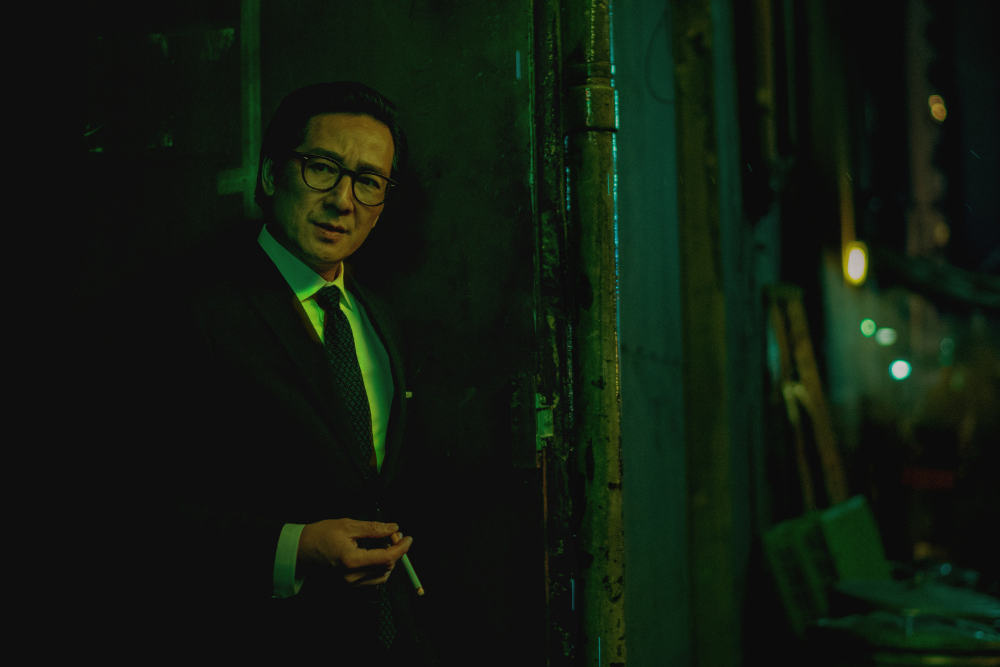
The divorce
Evelyn faces two major challenges to her life during the film: her husband asking for a divorce, and her relationship with her daughter. Let’s examine the divorce scenario as it is a bit simpler and easier to deal with. That’s probably the first time somebody has described a divorce as simple and easy to deal with, but here we are.
Evelyn’s husband loves her, he wants her to be happy and he is happy in whatever existence they are in. He embodies many of the best traits of a bodhisattva, he appears to live in the moment as a enlightened person. Evelyn, on the other hand, appears to be living anywhere but the moment. Her mind is always either on the past, or on the future.
This difference in mindset causes strife in her marriage as she constantly feels the need to plan, or prepare, for some future event or possibility. She never has enough time for her marriage, as the future contains an infinite number of things to worry about and plan for. A person absorbed in this pursuit will not have energy for the moment-to-moment “stuff” that is life. Her husband interprets this as resentment, he believes that she resents him for taking her from her family. He believes that her absorption into her fears is a reflection on him, he is holding her back.
So he seeks a divorce. She doesn’t have time to even look at the papers she is holding though. Like so many of us, too focused on worry and fear to address the present moment. It isn’t until she severs into two Evelyns while in the IRS that this real Evelyn finally has time to deal with the present. The other Evelyn can go on trying to solve those future problems, but this Evelyn has to remain in the camper, in the real world.
We can think of each sequence of the quantum leap Evelyn encountering her husband as the real Evelyn remembering something she forgot. These aspects of her past return to her as she is going through the motions of real life, just as they do to all of us. In the context of knowing that her husband is seeking a divorce, these sequences take on a new meaning.
Now we are seeing her meditating on the various paths she could choose, but the stress of the ongoing divorce forces her thoughts into the past. She keeps encountering her husband and seeing him and his actions in a different light. Only through the exercise of exploring these other paths was she able to come to the decision to keep working on her marriage.

The relationship with her daughter
This is the primary and most complex plot line in the film. Evelyn comes from a traditional Chinese family. She was abandoned by her father when she decided to marry her husband and move to America. Now her father is old and has lost his memory of this, she still lives with that deep pain of abandonment.
She has a daughter. Her daughter is a lesbian and while Evelyn seems mostly ok with this, she is not ok sharing that with her father. She feels this will make her father think less of her, as if she failed as a mother in some way.
By combining these two feelings, that of abandonment and failure, we can clearly see Evelyn’s motivations in all of these crazy events. The crisis of her divorce kicks off the furious search for the right path forward for her. That search forces her to explore options she isn’t sure she really should. All of this is going on in her mind, maybe in dreams or those moments between moments where we ponder our existence. The real Evelyn is sitting in a camper back in Samsara.
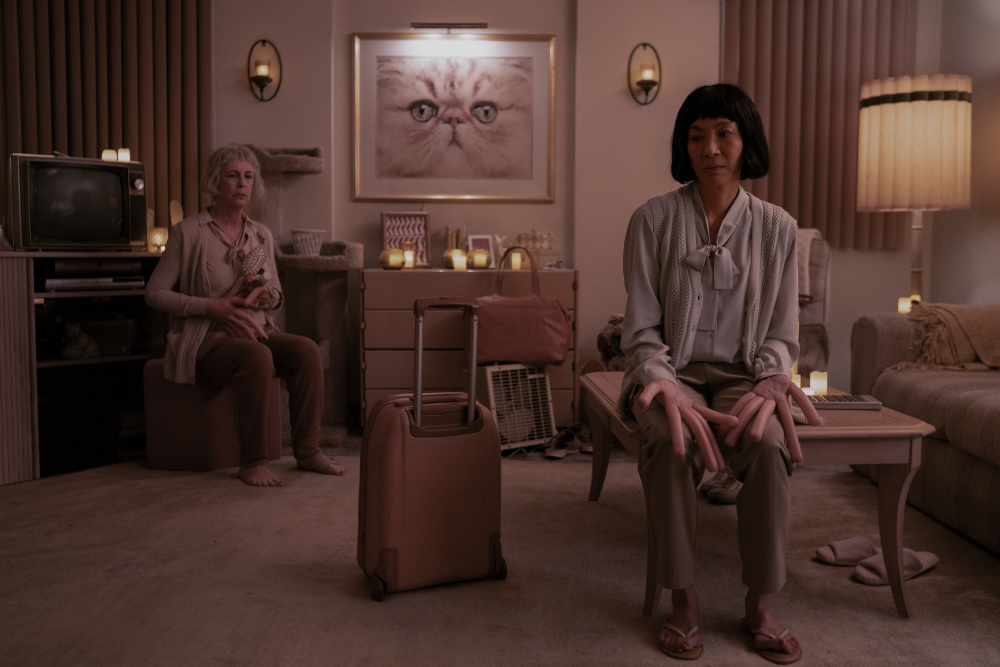
Hotdog fingers?!?
Consider the most absurd sequence in the film, the hotdog finger scenes. Are these just silly comic relief, a chance to escape the deeper themes of the film and laugh a bit? No, sorry. These scenes represent the most repressed part of Evelyn, this is the part her mind can’t even consider without adding these absurd elements like hotdog fingers.
In these scenes Evelyn is also a lesbian and she is in a relationship with the IRS agent performing their audit. From a freudian psychology point of view this scenario makes perfect sense. The real Evelyn is under tremendous stress over her divorce, her daughter’s lifestyle choice and the IRS audit. To have all those elements combine in one thought is simply too much for Evelyn to truly consider. She cannot actually see herself on this path, so hotdog fingers it is.
None of this seems especially related to her daughter at the time it is presented, however this is absolutely Evelyn processing those feelings. This is the only way she can. Together with the realization that her grandfather is not really worth idolizing in the way she did — these scenes are what allow Evelyn to finally come to terms with living a life where she has a lesbian daughter and that is ok.
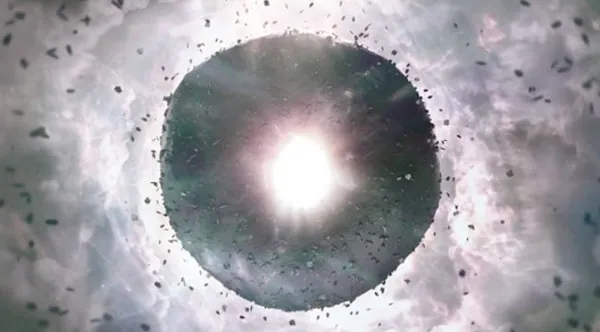
An everything bagel – or a dark Torus?
This is the most talked about aspect of the film we suspect, we’ve read many articles focused solely on the meaning of this bagel. Why are we so enamored with this? Like the characters in the film we seem drawn to this concept.
A bagel, which in mathematics we call a torus, is a three dimensional shape with only one surface and no edges. It is similar to other shapes like the Klein bottle, but the torus is the simplest form that has these two attributes.
By placing everything onto the torus, Jobu Tupaki creates a sort of anti-torus, or dark torus. A black hole but with only one surface, the center is also the outside. Such a shape is then said to be a way out of the multiverse existence the characters find themselves in.
Samsara can be a horrible place, without the tools and knowledge to process it, just thinking about the infinity of our existence is too much for most people. This causes them existential dread. The idea that there is a way out has been dangled in front of us by religion since the very first ones. People yearn for a heaven or a nirvana to work towards, something other than just brushing teeth for all eternity.
There is no way out. The torus is as much a lie as nirvana or heaven is. We’re given this lie in the movie to represent a choice that Evelyn could make. The annihilation choice. She could walk away from everything, from her husband, from her daughter, from her father, everything. Making that choice is equivalent to annihilating your past and starting over.
There are many times in our lives where this choice seems like a way out, but it never is. This is what Evelyn realizes near the end of the film, when she begins to heal her wounds rather than fight. The final wound, her relationship with her daughter can only be healed on the threshold of annihilation.
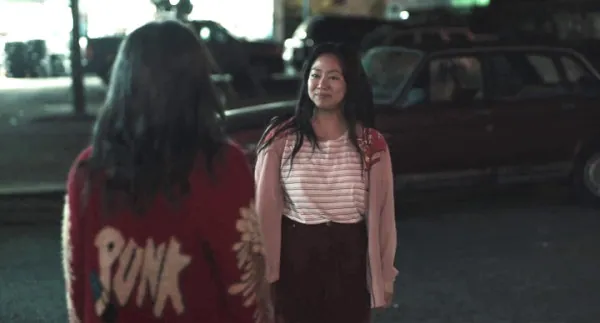
Reconciliation
From that precipice we return to the real Evelyn. She has been playing the game out of our view while all these thoughts and meditations are running through her mind. All this under the immense pressure of the IRS audit, divorce papers, and losing her daughter the way her father lost her.
Real Evelyn does crack. She picks up a baseball bat and starts smashing things. The police arrive with the IRS agent to seize her business, her husband is dealing with that while she is venting a lifetime worth of frustrations all at once.
Then, we see her heal, she heals the wounds with the IRS, the wounds with her husband and crucially, in a very difficult moment for her, the wound with her daughter. With these wounds healed she can begin to rebuild her relationships and live the life she wants, live the life she chooses.
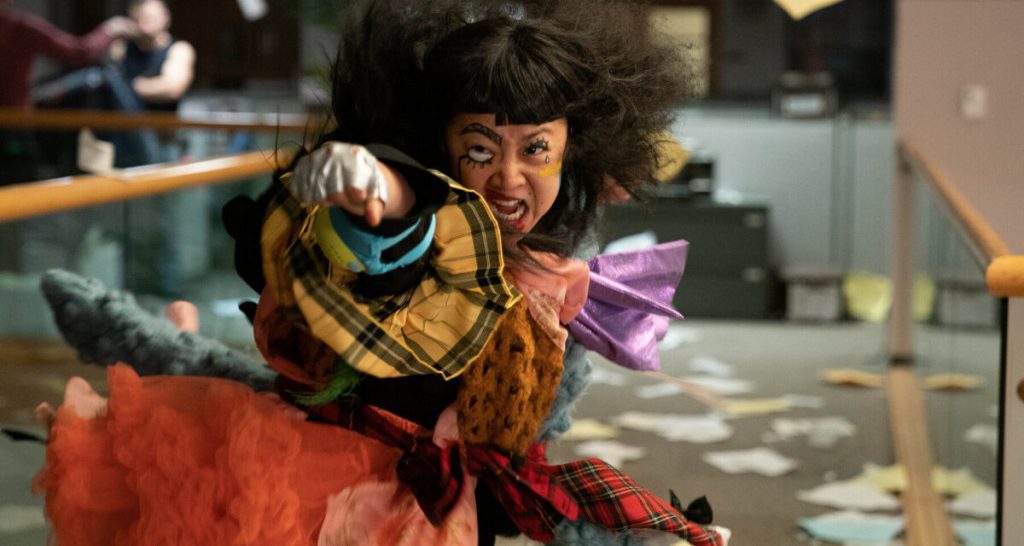
Conclusions
“The people who come back from these songs are the people we’re choosing to be”
Aunty Lucy, A Grueling Hike or How to be a Good Trip Sitter
This film has a lot to say but we feel the real lesson is that every one of us can be just like Evelyn. In fact, if we really see her story from this split point of view, what happened to her is kind of tragic. The tragedy of a nearly wasted life, only realizing a better way to live under the immense stress of losing both her husband and her daughter. Only at the very edge of annihilation was she able to change her mind.
This is the practical lesson for you, don’t live like Evelyn did, that is not something to aspire to. Live in the moment, play the game of life but realize that it is a game. Don’t take things so seriously and you won’t end up where Evelyn was, at this crisis moment. Given any decision, take the time to consider the options, rushing through life without caring about these decisions is what put Evelyn in that place.
The psychedelic state of mind, whether achieved through meditation or chemical assistance, is a wonderful tool to help you truly explore these options. You can put yourself fully into another existence for a little while, choose the parts you want to keep, and then bring those back to help you become a better person here in the real world.
Don’t let your own life reach that crisis point, get back in the game and start your own healing today.
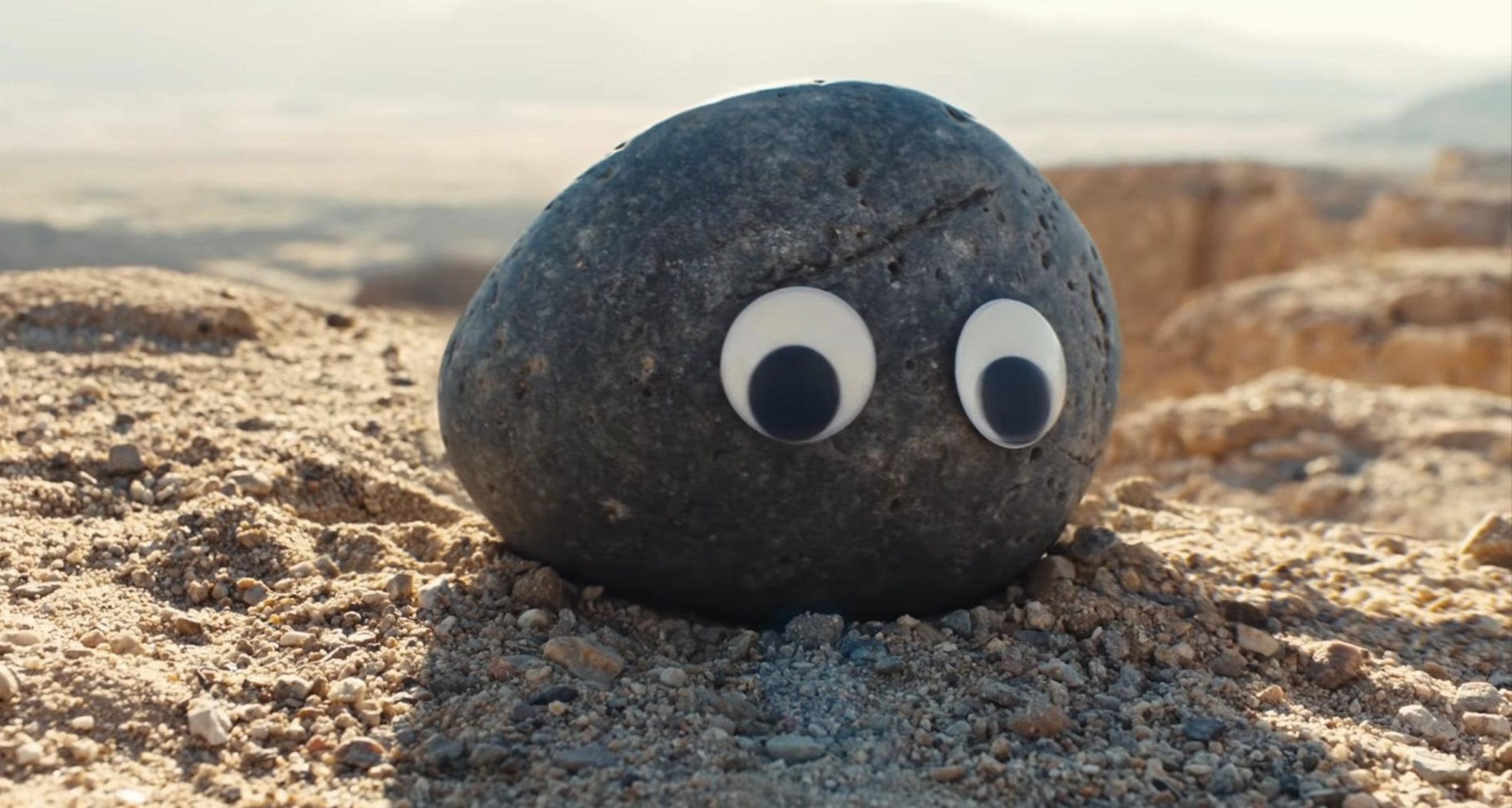
Leave a Reply